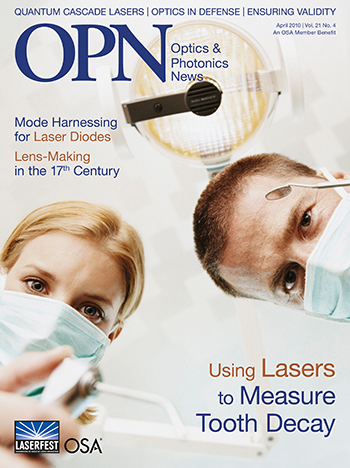
April 2010 Issue
Feature Articles
Lasers and Optics for Measuring Tooth Decay
Lasers may finally provide dental patients a good reason to open up and say ahhhh. Dentists are already using optical technologies to detect tooth decay and lasers for therapeutic interventions, and they are looking to a future in which they can combine these methods for minimally invasive dentistry.
by Daniel FriedMode Harnessing for Laser Diodes
Recent experiments have shown that the modal structure of broad-area edge-emitting semiconductor lasers is box-like, with each lateral mode having a distinct wavelength. Thus, researchers can now reshape lateral modes and effectively combine all multimode laser output into a single-mode fiber. This approach provides a promising means for delivering high-power, high-speed modulated beams of any wavelength that are directly radiated from semiconductor lasers.
by Nikolai Stelmakh and Michael VasilyevTelescope Lens-Making in the 17th Century: The Legacy of Vangelista Torricelli
In the early days of instrumental optics, the know-how of lens making was shrouded in secrecy. A remarkable exception can be found in a letter from 1643, in which the Italian lens-maker Vangelista Torricelli gives his correspondent directions on optical shop practices.
by Giuseppe MolesiniDepartments and Columns
Optics and the U.S. Department of Defense
The U.S. Department of Defense is a major source of support for optics research done in American labs, academic institutions and private businesses.
A Large, Real-Time 3-D Display
A Chinese team’s 3-D display system delivers 1.8-m-tall images that don’t require polarized glasses or other specialized viewing devices.
Profiles in Optics: Wallace R. Brode
The life and career of a former JOSA editor and OSA president.
For scientists, peer review is the time-tested method for establishing scientific facts. But how can we educate a public that is growing accustomed to challenging a consensus they don’t understand?
Quantum Cascade Lasers Gain Efficiency
Researchers have fabricated Quantum cascade lasers (QCLs) that significantly boost “wall plug efficiency,” or the ratio of the power the laser emits to the power that the device consumes.
Using scanning lidar data to analyze wildfire smoke plumes.
Also in this Issue
The OSA Foundation (OSAF) expresses much appreciation to its 2009 contributors. Since its establishment in 2002, the Foundation has funded more than 235 programs that have benefited thousands of individuals in more than 55 countries.
Remembering James H. Schulman and Indrek Martinson.


![Manual probe system with needles for test of semiconductor on silicon wafer. [A. Morozov / Getty]](https://opnmedia.blob.core.windows.net/$web/opn/media/images/articles/2025/1125/departments/202511-cover-web.jpg?ext=.jpg)
![Researcher Clara Saraceno in the lab. [Image by Carsten Behler Photography]](https://opnmedia.blob.core.windows.net/$web/opn/media/images/articles/2025/1025/departments/202510-cover-web.jpg?ext=.jpg)
